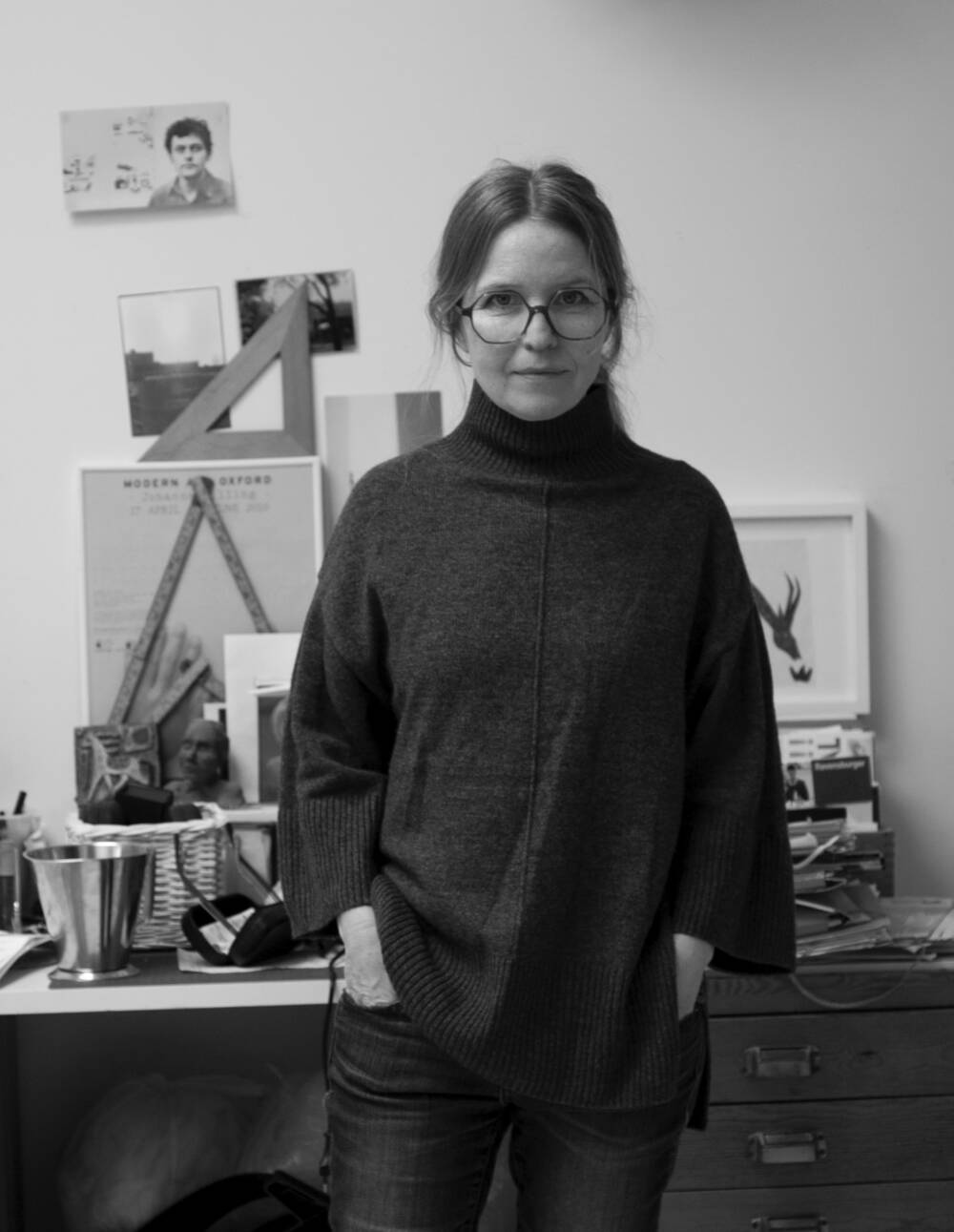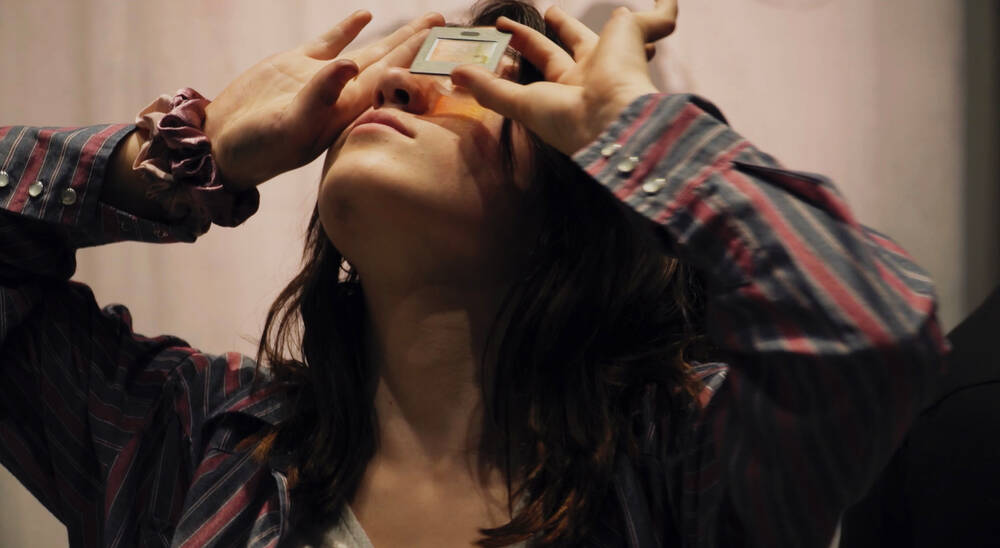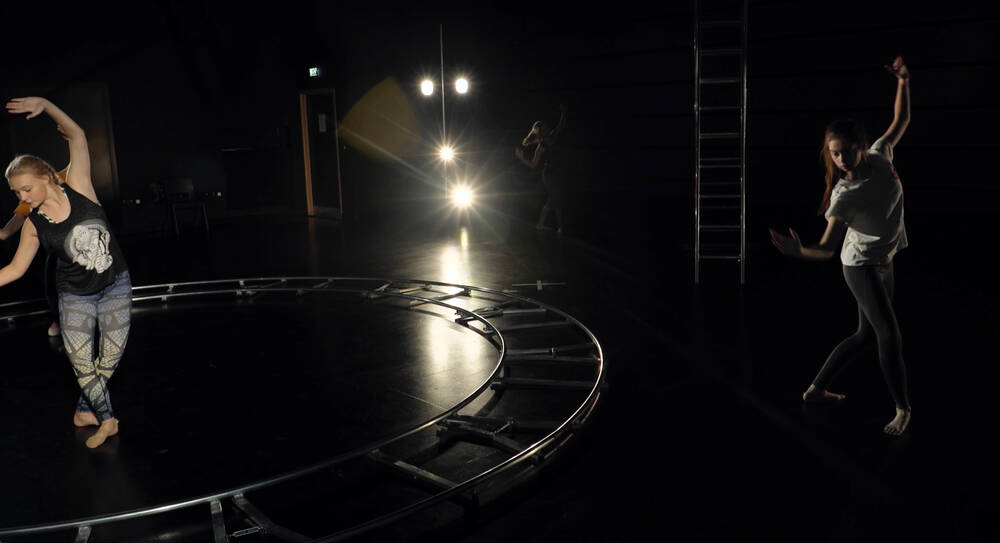John Cage’s “Untitled Event” (1952) is felt to mark the birth of performance art, but there is only anecdotal evidence as to what it actually featured. In our DOUBLE FEATURE, with the help of school students Johanna Billing re-imagines the event – and exploits the uncertainties in order to counter the professionalization of the school sector.
We hear a church bell ring, birds chirp away happily. The camera shows still images of an urban setting in Britain, historical buildings set against a blue sky, a car drives past, we spy a grassy inner courtyard. Signs eventually reveal where exactly we are, namely at the 1532 Performing Arts Centre at Bristol Grammar School, an independent school in southwest England. In her 2022 video entitled “Each Moment Presents What Happens”, Swedish concept artist Johanna Billing delves ever deeper into the lively world of the center. A piano is carried into the building, a dolly used to enable smooth camera tracking shots does the rounds in a dark studio while various reed instruments play simultaneously.
An homage to the birth of performance art
Johanna Billing spent several years working on the project; the images which we see were then actually produced in a single day in collaboration with the school pupils. The video was commissioned by Bristol Grammar School on the occasion of the opening celebrations for the 1532 Performing Arts Centre. Leaning against a ladder, a girl student declaims the following words to the space before her: “This is a talk about something and naturally also a talk about nothing. About how something and nothing are not opposed to each other but need each other to keep on going.” The text was penned by American composer and artist John Cage, and the words form the opening to “Each Moment Presents What Happens” and set the frame of reference for Billing’s piece.

In 1952, Cage held the “Untitled Event” (also known as “Theatre Piece no.1”) at Black Mountain College, a progressive, interdisciplinary institute in North Carolina – many today consider it the moment when Performance Art was born. However, what exactly was involved and how the event unfolded is now only known on the basis of anecdotal evidence: Together with artists such as painter Robert Rauschenberg, dancer and choreographer Merce Cunningham, and poet M. C. Richards, Cage organized the event in the college’s refectory. There is no documentation of the performance, and thus all knowledge of the “Untitled Event” stems from the in part mutually contradictory recollections of those who participated. Indeed, it is unclear how long the performance actually lasted (statements vary between 45 minutes and two hours), when exactly it took place (evidently at some point in August 1952), and what actually happened. Cage himself later said: “I don’t recall anything […] except the ritual with the coffee cup.”

In “Each Moment Presents What Happens”, together with the school students Johanna Billing re-imagines that myth-shrouded event. Central elements are text passages from Cage’s “Lecture on Something”, that are declaimed in the dark studio or in the school’s cafeteria, musical and dance improvisations, and a so-called prepared piano. The latter is a technique that Cage dreamed up whereby everyday objects are placed on or between the strings of a grand piano such as to cause the instrument to produce new sounds. The students chose to fasten erasers, brushes, toy autos, cooking spoons or polystyrene panels between the piano’s strings, which thus produced overtone-rich, percussive sounds. In-between, Johanna Billing repeatedly presents everyday scenes from a day at school: children in the yard during break time, or eating in the cafeteria, installation work, preparing the food in the canteen. The musical and performative sounds gradually mix with the everyday sounds of school life and give rise to a quite unique soundscape. “When I came over there, I remember I had just read this study about how young people today fear actually failure more than the death of someone close,” the artist recently recalled in an interview with London’s Whitechapel Gallery.

An open, spontaneous form, a tonally liberated aural world, a performance based on oral myths: The joint piece created with the pupils thus also becomes an attempt to counteract the ever more widespread professionalization of school life and bring to mind that improvisation and failure are both forces driving creativity. And they were the real basis of the preparatory work, as Johanna Billing explains: Giving rise to a situation which all participants could get involved in without in advance knowing where it would lead.

As her other film, Johanna Billing chose “Ole dole doff” (English title: “Who saw him die?”) by Swedish director Jan Troell; it won the Golden Bear at the 1968 Berlin International Film Festival. The coarse-grained 16mm black-and-white film traces the everyday life of teacher Sören Mårtensson (Per Oscarsson) at the Sorgenfriskolan, the “Carefree School” in Malmö. Sweden. School education, as he explains to those present at a PTA evening, has arrived at a crossroads, the one path leading to authoritarian compulsion, the other to liberal-democratic teaching.
A teacher on the verge of a nervous breakdown
The only problem is that the teacher lacks any authority, and his students opt for confrontation and conflict, something that causes him nightmares. In the classroom he ends up slapping a boy and is then disgusted with himself. At the same time, he increasingly withdraws from his wife Gunvor (Kerstin Tidelius). At work, he finds a confidante in the person of a colleague Ann-Marie (Ann-Marie Gyllenspetz) and confesses to her why he finds is so much harder than the other teachers: because he inwardly sides with the students.

movie poster: Jan Troell, Ole dole doff, 1968, Image via listal.com
The film was based on a book by Clas Engström, who wrote the script and like director Jan Troell was himself a teacher at the school in Malmö, which serves as the location for the movie. The semi-documentary forms and Per Oscarsson’s incisive acting turn the film into the tense psychological portrait of a man who is on the verge of a nervous breakdown and of losing a hold on himself. As the walking shadow of his former self, the teacher seeks recognition from those he is supposed to be teaching, and despairs given the youngsters’ radical rejection of him, as they find his uncertainty merely an irritation that needs to be expunged. A story from teaching hell in which any peaceful resolution seems out of reach.

Jan Troell, Ole dole doff, 1968, film still, Image via listal.com









